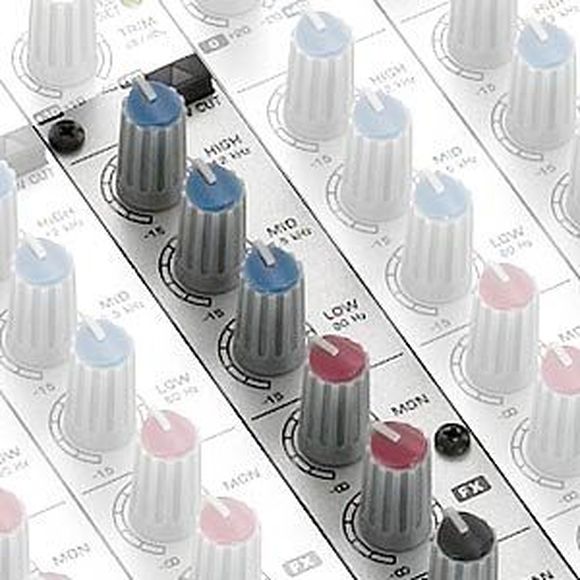3. Features
Most mid to high-end mixers draw from very similar feature sets, and tend to vary only in quality and channel and/or feature quantity. We'll now take a closer look at some of these basic features, as their explanation should provide a better understanding of the fundamentals of mixing, and will be useful in a broad variety of situations.
Input Channels
The most crucial factor when buying a mixer is the number and type of channels. The main distinction here are mono and stereo channels. The number of channels determines the quantity of available inputs. A mono channel (often referred to as a microphone channel) has one input, while a stereo channel has two inputs (right and left). A channel has, as a basic feature, at least a level control (volume), typically additional controls for level adjustment (gain), sound adjustment (EQ), spatial distribution (pan or balance), and (depending on the model's features) switches for pre-listening (PFL), phantom power, subgroup assignment, filter switches, and more. The equipment of the channels also includes the type of inputs (XLR, jack (balanced or unbalanced), RCA, etc.) and the presence of an insert for external effects.
Each signal source (microphones, instruments, tapes, etc.) should be allocated its own mixer channel. It's also advisable to consider having some reserves for possible band or application expansions.

Channel Faders
Master Section
A mixer consists of several channels and the master section. All signals from individual channels are mixed into a stereo signal (or multiple subgroups) in the master section. Subgroups provide additional flexibility for settings and effects. Subgroups can be added to the overall mix, but they can also be used independently from the master output for monitor mixes, recording mixes, etc. The master section typically includes the headphone output and additional features such as an equalizer, level meters, or an internal effects unit.
Sound Control
Usually, each channel has its own sound control. However, in small mixers, this control is often quite basic. Sometimes it's just a 2-band EQ (treble and bass), and sometimes it's a 3-band EQ (adding midrange), but rarely do these have parametric capabilities. There are often some tricks you can employ to achieve reasonably good results despite this "minimalist" setup. First, the gain control should be optimally adjusted to minimize noise. Then, if you lower the bass region a bit with the corresponding control (which may reduce the richness of the voice), the mix will stand out much better. Raising the midrange also enhances clarity (be cautious as it increases the risk of feedback). Setting mids and highs too high can lead to feedback, but it generally adds a silvery brightness to the voice. It's essential to balance how much you should alter the frequency response. With good equipment, there may be no need for any alterations at all. So, before making any adjustments, it's always a good practice to keep all sound controls in the neutral middle position and listen to see if the voice already sounds good.
Often, mixers have a more powerful equalizer for the master section. This allows for adjustments to the frequency response to accommodate room acoustics (for live performances) effectively.
Effect input
Another input, typically found on each mono channel and/or in the master section, with a corresponding control that allows for the insertion of external effects, indicates the presence of effect sends in a mixer. Effect sends enhance sound control possibilities but are not necessary for every application.
Subgroups
Subgroups provide clarity for live sound engineers by allowing for monitor mixing on the same mixer, and they facilitate live recording. In the studio, subgroups offer additional possibilities, such as adding effects to specific instrument groups or vocal tracks, etc.






